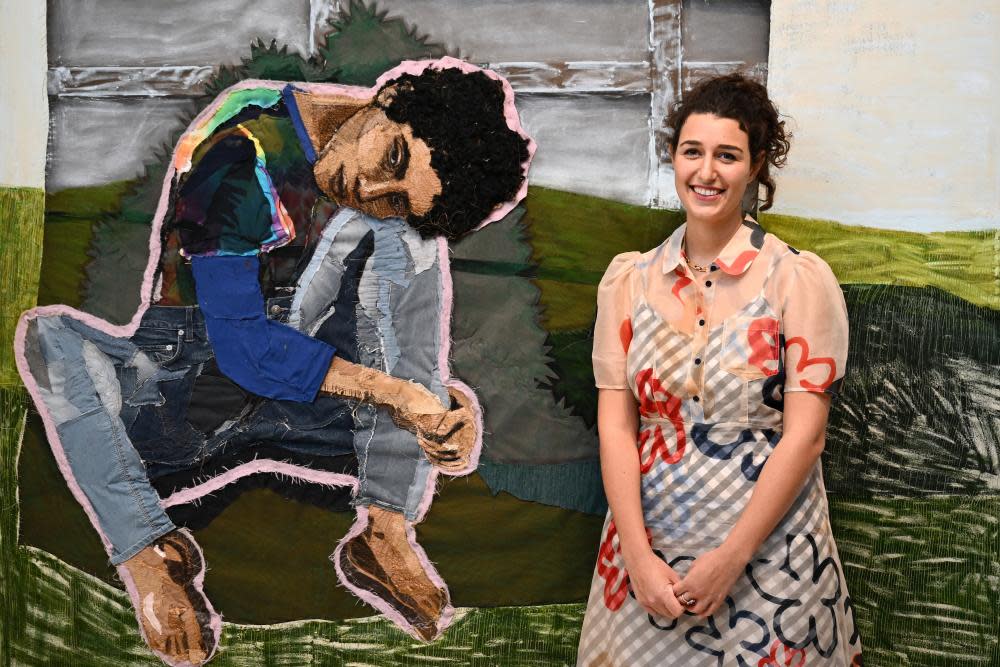Archibald prize 2023: Julia Gutman wins $100,000 for portrait of Montaigne

Julia Gutman has won the 2023 Archibald prize for her portrait of the Australian singer Jessica Cerro, better known as Montaigne.
Announced at the Art Gallery of New South Wales on Friday, the winning painting Head in the sky, feet on the ground was picked unanimously by the judges. It marks the 13th time the prize has been awarded to a woman since the Archibald started in 1921; and the first time a female musician has been the subject of a winning portrait.
Related: How to win the Archibald prize: what 100 years of data tells us
Gutman, 29, a first-time Archibald finalist, met the singer in a share house in Annandale three years ago. She said she was “elated and overwhelmed … shocked, dumbfounded, but very happy” to have won.
“It’s honestly completely surreal. I’m so grateful to be working at a time when young female voices are heard,” she said.
She appeared delighted at the suggestion she had shaken up an old institution: “I think it’s really exciting. I’m excited to see what the landscape of Australian paintings looks like going forward.”
Gutman said she wanted to convey a sense of interior and exterior spaces. “Jess is very online. Montaigne has this huge kind of online persona. She’s very famous on Twitch, her fans are largely teenagers.
“She’s got this kind of real online performative persona, and she’s also really introverted. And there’s sort of this duality of what’s outside and what’s inside what’s public and private. So the work is kind of trying to collapse those things together and sort of show that public and private at once.”
In her artist’s statement, Gutman explained that that Cerro’s pose was mimicking that of “Egon Schiele’s Seated woman with bent knees, a painting of his wife Edith that subverted conventional representations of femininity when he composed it in 1917.
“Like Edith, Montaigne’s figure is distorted: at once angular and soft, representational and imagined. She sits in a vaguely suggested landscape, fragmented by a translucent screen, online and offline at once,” she said.
As Montaigne, Cerro represented Australia at Eurovision in 2021. In a statement after the win, she said: “I sure didn’t see it coming, not because I don’t believe in Julia’s incredible talent and warm heart, but because you just never think this stuff is going to happen to you.”
On Thursday Cerro had posted a joke about the portrait winning the Archibald; on Friday she shared her dazed reaction. “I was joking about us winning the Archibald prize yesterday because I didn’t think we actually would - but we did win,” she said, laughing.
The $100,000 prize is awarded to the best portrait of a person “distinguished in art, letters, science or politics” painted by an Australian resident and has been running since 1921. The AGNSW received 949 entries for this year’s Archibald, coming close to the record set in 2020.
Also announced on Friday, Zaachariaha Fielding – of the pop-electronic duo Electric Fields – won the $50,000 Wynne prize for landscape painting of Australian scenery or figurative sculpture.
Fielding is a first-time entrant. His work, titled Inma – which means “song and dance” – depicts the sounds of Mimili, a small community in Aṉangu Pitjantjatjara Yankunytjatjara Lands where he was raised.
Related: Cal Wilson portrait wins packing room prize at 2023 Archibalds
“This is a memory that I was able to document which happened in Paralpi,” Fielding said in his artist statement. “It’s a place that’s like the Sydney Opera House for the APY Lands! It’s where people come to embrace and celebrate children, teaching them how to move and mimic their clan emblem – and, for Mimili, this has always been the maku (witchetty grub).
“The atmosphere of this work is full of sound, movement and teaching. All of the communities [are] coming together, shar[ing] their storylines. However, this platform is only for children. This is for the babies and it’s about them being taught by the masters, their Elders.”
The $40,000 Sulman prize for best subject painting, genre painting or mural project –in oil, acrylic, watercolour or mixed media – was won by the Luritja artist Doris Bush Nungarrayi for her work Mamunya ngalyananyi (Monster coming).
Nungarrayi was born in Ikuntji, 250km west of Alice Springs, and was married to the late artist George Bush Tjangala. According to the statement accompanying her artwork, the piece depicts “ominous and malevolent spirits that terrify Aṉangu” known as mamus, or “cheeky ones”.
“They are typically seen to have large haunting eyes, straight hair standing upright, and can shapeshift into many different forms, including the human figure. The mamu usually hide in underground dwellings or inside hollow trees.”
Nungarrayi was also a finalist in this year’s Wynne prize.
Related: Archibald prize 2023 finalists: Sam Neill, Archie Roach, Claudia Karvan and more – in pictures
This year there were 57 finalists vying for Australia’s oldest national portrait prize, with 30 of those women – a rare majority for a prize that has often skewed male.
A record 38 Indigenous artists were among the 143 finalists for the Archibald, Wynne and Sulman prizes, compared with 27 last year. Overall there were 2,348 entries across the three prizes.
This year’s winner of the packing room prize – a category decided by the staff hanging the portraits in the AGNSW – went to Andrea Huelin’s portrait of the comedian Cal Wilson last week, with the artist winning $3,000.
The finalists for the Archibald, Wynne and Sulman prizes will be on show at AGNSW from 6 May until 3 September.

 Yahoo News
Yahoo News 
